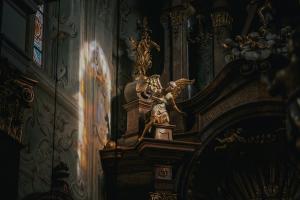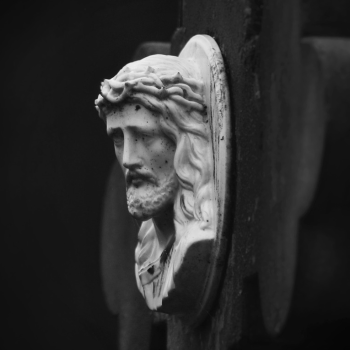
As Catholics, we should “be ready to give an explanation to anyone who asks you for a reason for your hope.” (1 Peter 3:15). How can this be done? Enter apologetics.
Because the word apologetics sounds very similar to the word apology, it may seem that Catholics are to express regret or remorse for their faith. This could not be farther from the truth. Apologetics is the English translation of the Greek word apología, which means to give a systemic and reasoned defense of one’s beliefs and actions. The most famous example of this is The Apology of Socrates.
Since Catholic apologetics is generally categorized into three approaches: classical, evidentialist, and presuppositional, I will devote one paper to each type of method. This essay will focus on classical apologetics.
The classical method is usually attributed to Saint Anselm and Saint Thomas Aquinas. Historically, the classical method consisted of two steps. First, one presented arguments for the existence of God. Second, one sought to establish that such a being is the God evidenced in the Judeo-Christian tradition: the God of the Bible. Recently, some have added a third step, which is to argue for the truth of Catholicism. I will adhere to this three-step approach to the classical method.
Both theology and philosophy have developed arguments for proving the existence of God. One of the more unique arguments utilized by the classical method is the ontological argument. Ontology is a subset of metaphysics that studies the nature of existence. The argument is formulated this way:
By definition, God is a being that which none greater can be imagined. A being that necessarily exists in reality is greater than a being that does not necessarily exist.
Thus, by definition, if God exists as an idea in the mind but does not necessarily exist in reality, then we can imagine something greater than God. However, we cannot imagine something greater than God.
Thus, if God exists in the mind as an idea, then God necessarily exists in reality. God exists in the mind as an idea. Therefore, God necessarily exists in reality.
As one can see, the argument is a priori. That is, the ontological argument is not reliant on experience but solely on reason and logic. The ontological argument does not exhaust the proofs for God’s existence. It is, however, the one most associated with the classical method of apologetics.
Having sought to establish the existence of God, the second step is to show why such a deity is consistent with the God depicted in the Bible.
According to some anthropological studies, human history has seen the worship of approximately eighteen thousand different gods. In light of such staggering numbers, why is the Christian God – the God of the Bible – the one true God?
In his outstanding work Introduction to Christianity, Pope Benedict XVI observes that the God of Christianity is the God of philosophy. The scriptural data suggest that God is one, eternal, and personal. Therefore, a philosophical approach must eliminate polytheism and pantheism and provide evidence of a personal God.
By definition, God possesses every possible perfection, including existence. If multiple gods existed, then they would differ from each other. A property or attribute would belong to one god that did not belong to another. However, this entails a privation of some good which is impossible if God is that which possesses every perfection. Therefore, the belief in many gods is not tenable, and polytheism is false.
Pantheism asserts that the universe – and everything in it – is God. Obviously, pantheism is unbiblical, but it is also untenable from a philosophical perspective. The universe is itself an effect and does not exist necessarily. What does not exist necessarily must be caused by another. However, God cannot be caused by another while simultaneously existing necessarily. Therefore, the universe cannot be God. Moreover, as time began with the universe, the cause of the universe (i.e., God) must exist independent of time. That is, God must be eternal.
Finally, we can infer that God is a personal being using the same line of reasoning. It has been shown that the universe is contingent. Whatever is contingent does not exist necessarily, and what does not exist necessarily is a result of a choice. Choice is a product of the will, and the will is a power of an intellect. An intellect can only exist in a personal being. It follows then that the first cause (God) is a personal being.
The final step in the classical apologetics method is to argue for the truth of Catholicism. Is it possible to show that Catholics worship the God proven by philosophy and revealed to human beings in the Bible?
As an act of faith, Christianity asserts that God became a human being (without ceasing to be God). Faith is not irrational, but rather it is suprarational. In this case, this act of faith is predicated on the historical record of Jesus of Nazareth. Put differently, Catholicism believes that the historical person Jesus of Nazareth is also God incarnate. This is evidenced by the actions of Jesus, in particular, the Resurrection.
Most important to the subject at hand is that God (in the person of Jesus) created the Catholic Church. Jesus did this by installing Peter as the Church’s first pope. “And so I say to you, you are Peter, and upon this rock [a play on Peter’s name] I will build my church, and the gates of the netherworld shall not prevail against it.” (Matthew 16:18). It is this statement by Christ combined with the events of Pentecost that testify to the truth of Catholicism.
Apologetics, like faith itself, is illative. That is to say that apologetics is composed of a series of inferences. Of course, some inferences are more persuasive than others. In the preceding essay, I have endeavored to provide a brief overview of one such method called classical apologetics.













